Promotion of Health of Aboriginal People
VerifiedAdded on 2023/06/08
|16
|5071
|137
AI Summary
The article discusses the problems faced by aboriginal women in Australia, including gender discrimination and sexual abuse. It highlights the lack of education and knowledge of the consequences of sexual abuse among aboriginal women. The project aims to promote the health of aboriginal people through individual risk reduction, awareness and education at the individual level, and holistic community development. The article emphasizes the need for proper infrastructure and sensitization to curb the exploitation of aboriginal women.
Contribute Materials
Your contribution can guide someone’s learning journey. Share your
documents today.
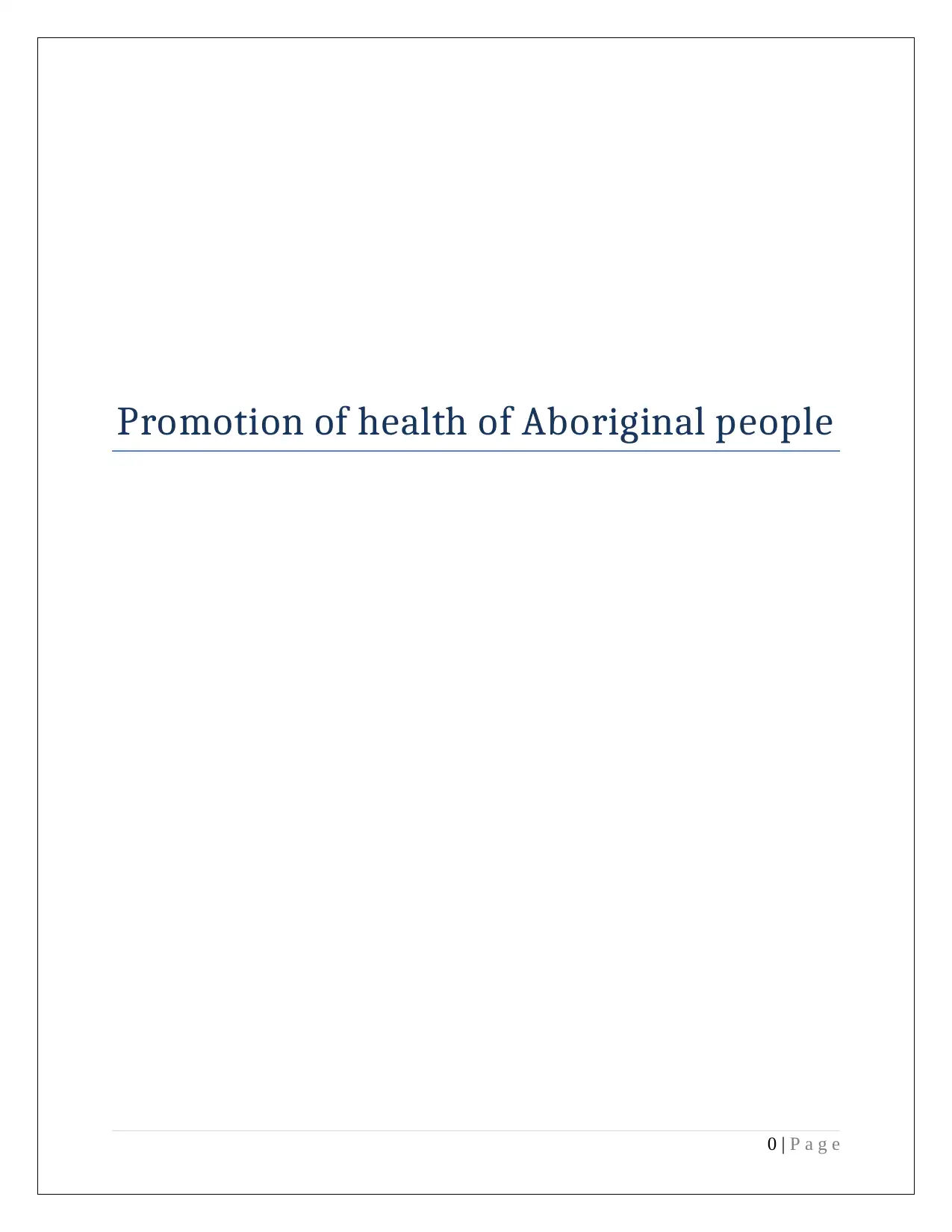
Promotion of health of Aboriginal people
0 | P a g e
0 | P a g e
Secure Best Marks with AI Grader
Need help grading? Try our AI Grader for instant feedback on your assignments.
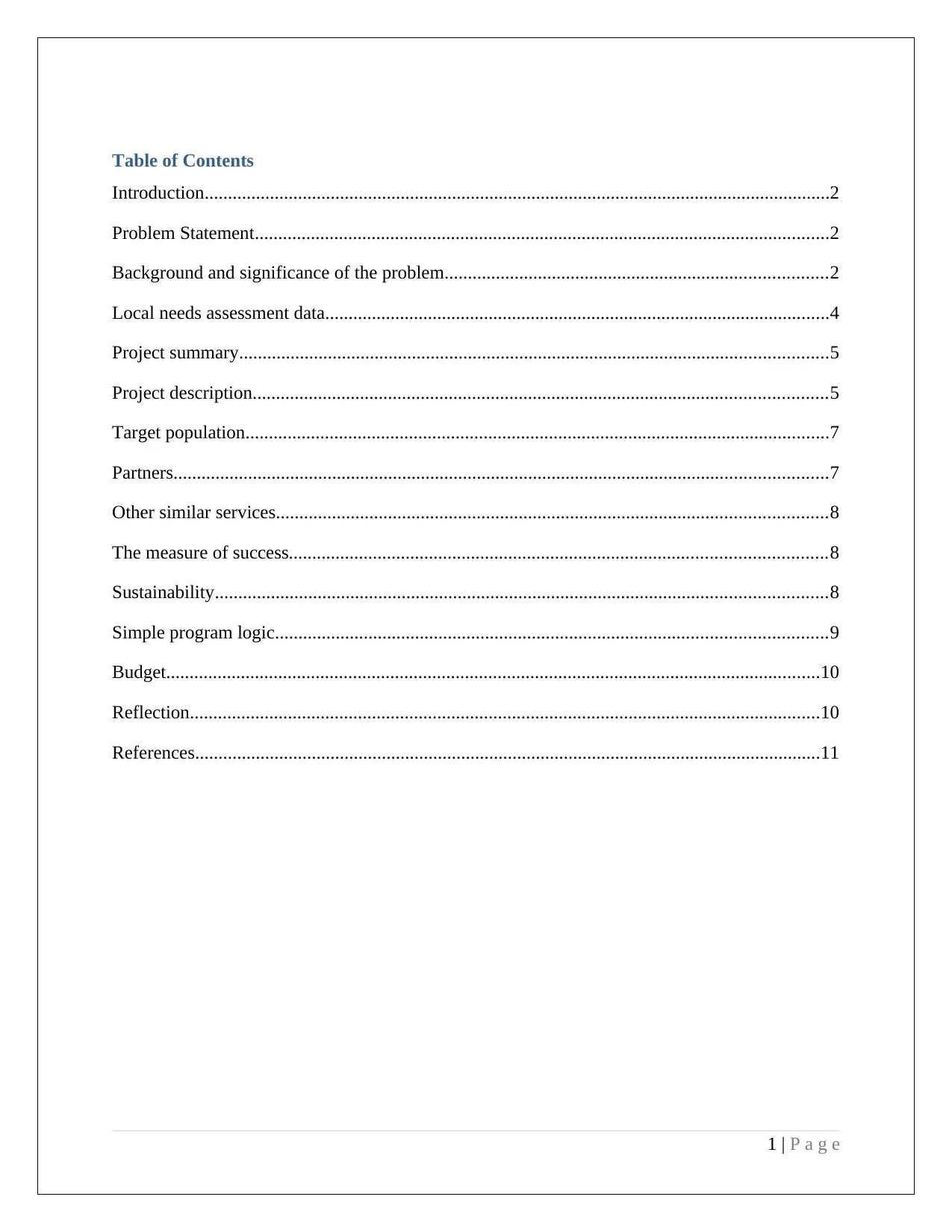
Table of Contents
Introduction......................................................................................................................................2
Problem Statement...........................................................................................................................2
Background and significance of the problem..................................................................................2
Local needs assessment data............................................................................................................4
Project summary..............................................................................................................................5
Project description...........................................................................................................................5
Target population.............................................................................................................................7
Partners............................................................................................................................................7
Other similar services......................................................................................................................8
The measure of success...................................................................................................................8
Sustainability...................................................................................................................................8
Simple program logic......................................................................................................................9
Budget............................................................................................................................................10
Reflection.......................................................................................................................................10
References......................................................................................................................................11
1 | P a g e
Introduction......................................................................................................................................2
Problem Statement...........................................................................................................................2
Background and significance of the problem..................................................................................2
Local needs assessment data............................................................................................................4
Project summary..............................................................................................................................5
Project description...........................................................................................................................5
Target population.............................................................................................................................7
Partners............................................................................................................................................7
Other similar services......................................................................................................................8
The measure of success...................................................................................................................8
Sustainability...................................................................................................................................8
Simple program logic......................................................................................................................9
Budget............................................................................................................................................10
Reflection.......................................................................................................................................10
References......................................................................................................................................11
1 | P a g e
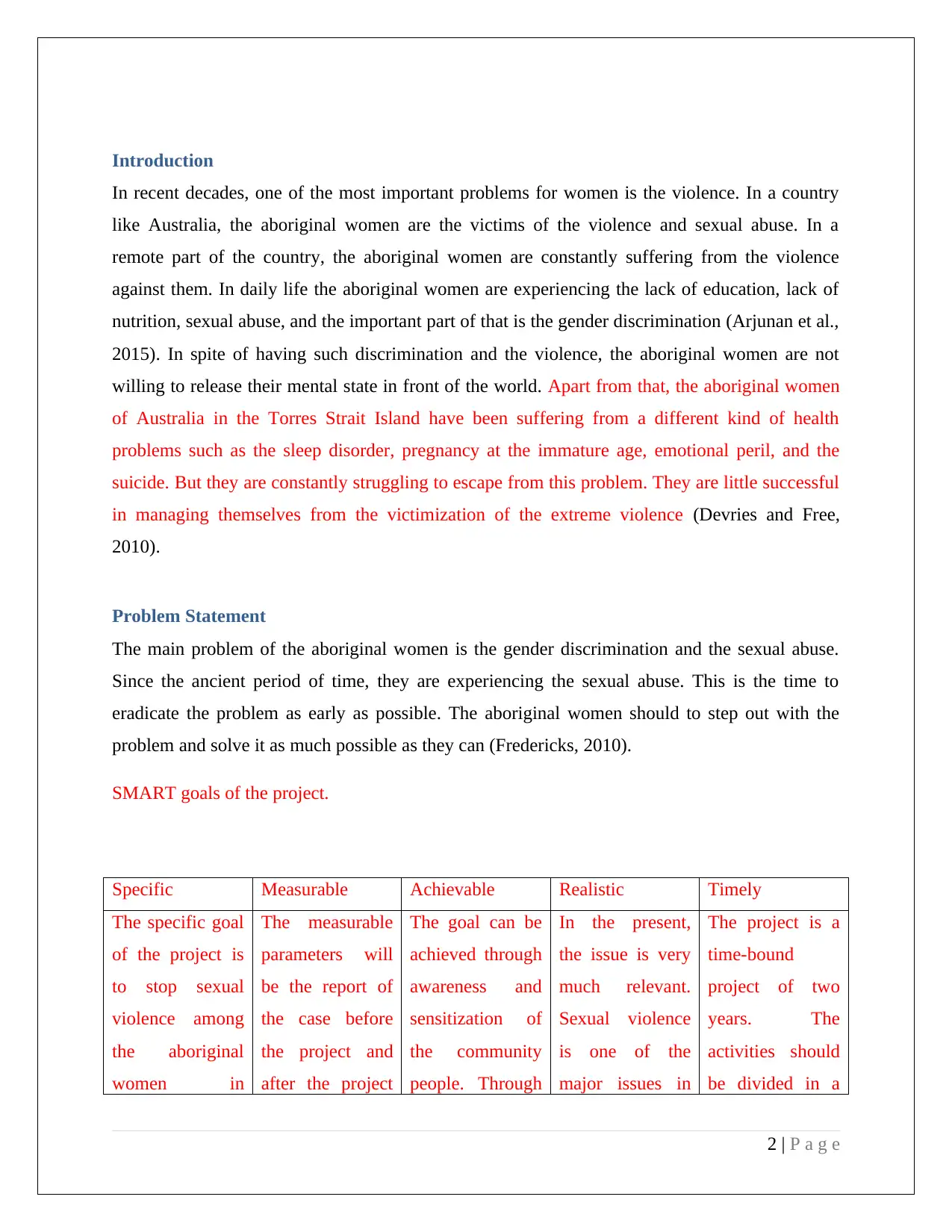
Introduction
In recent decades, one of the most important problems for women is the violence. In a country
like Australia, the aboriginal women are the victims of the violence and sexual abuse. In a
remote part of the country, the aboriginal women are constantly suffering from the violence
against them. In daily life the aboriginal women are experiencing the lack of education, lack of
nutrition, sexual abuse, and the important part of that is the gender discrimination (Arjunan et al.,
2015). In spite of having such discrimination and the violence, the aboriginal women are not
willing to release their mental state in front of the world. Apart from that, the aboriginal women
of Australia in the Torres Strait Island have been suffering from a different kind of health
problems such as the sleep disorder, pregnancy at the immature age, emotional peril, and the
suicide. But they are constantly struggling to escape from this problem. They are little successful
in managing themselves from the victimization of the extreme violence (Devries and Free,
2010).
Problem Statement
The main problem of the aboriginal women is the gender discrimination and the sexual abuse.
Since the ancient period of time, they are experiencing the sexual abuse. This is the time to
eradicate the problem as early as possible. The aboriginal women should to step out with the
problem and solve it as much possible as they can (Fredericks, 2010).
SMART goals of the project.
Specific Measurable Achievable Realistic Timely
The specific goal
of the project is
to stop sexual
violence among
the aboriginal
women in
The measurable
parameters will
be the report of
the case before
the project and
after the project
The goal can be
achieved through
awareness and
sensitization of
the community
people. Through
In the present,
the issue is very
much relevant.
Sexual violence
is one of the
major issues in
The project is a
time-bound
project of two
years. The
activities should
be divided in a
2 | P a g e
In recent decades, one of the most important problems for women is the violence. In a country
like Australia, the aboriginal women are the victims of the violence and sexual abuse. In a
remote part of the country, the aboriginal women are constantly suffering from the violence
against them. In daily life the aboriginal women are experiencing the lack of education, lack of
nutrition, sexual abuse, and the important part of that is the gender discrimination (Arjunan et al.,
2015). In spite of having such discrimination and the violence, the aboriginal women are not
willing to release their mental state in front of the world. Apart from that, the aboriginal women
of Australia in the Torres Strait Island have been suffering from a different kind of health
problems such as the sleep disorder, pregnancy at the immature age, emotional peril, and the
suicide. But they are constantly struggling to escape from this problem. They are little successful
in managing themselves from the victimization of the extreme violence (Devries and Free,
2010).
Problem Statement
The main problem of the aboriginal women is the gender discrimination and the sexual abuse.
Since the ancient period of time, they are experiencing the sexual abuse. This is the time to
eradicate the problem as early as possible. The aboriginal women should to step out with the
problem and solve it as much possible as they can (Fredericks, 2010).
SMART goals of the project.
Specific Measurable Achievable Realistic Timely
The specific goal
of the project is
to stop sexual
violence among
the aboriginal
women in
The measurable
parameters will
be the report of
the case before
the project and
after the project
The goal can be
achieved through
awareness and
sensitization of
the community
people. Through
In the present,
the issue is very
much relevant.
Sexual violence
is one of the
major issues in
The project is a
time-bound
project of two
years. The
activities should
be divided in a
2 | P a g e
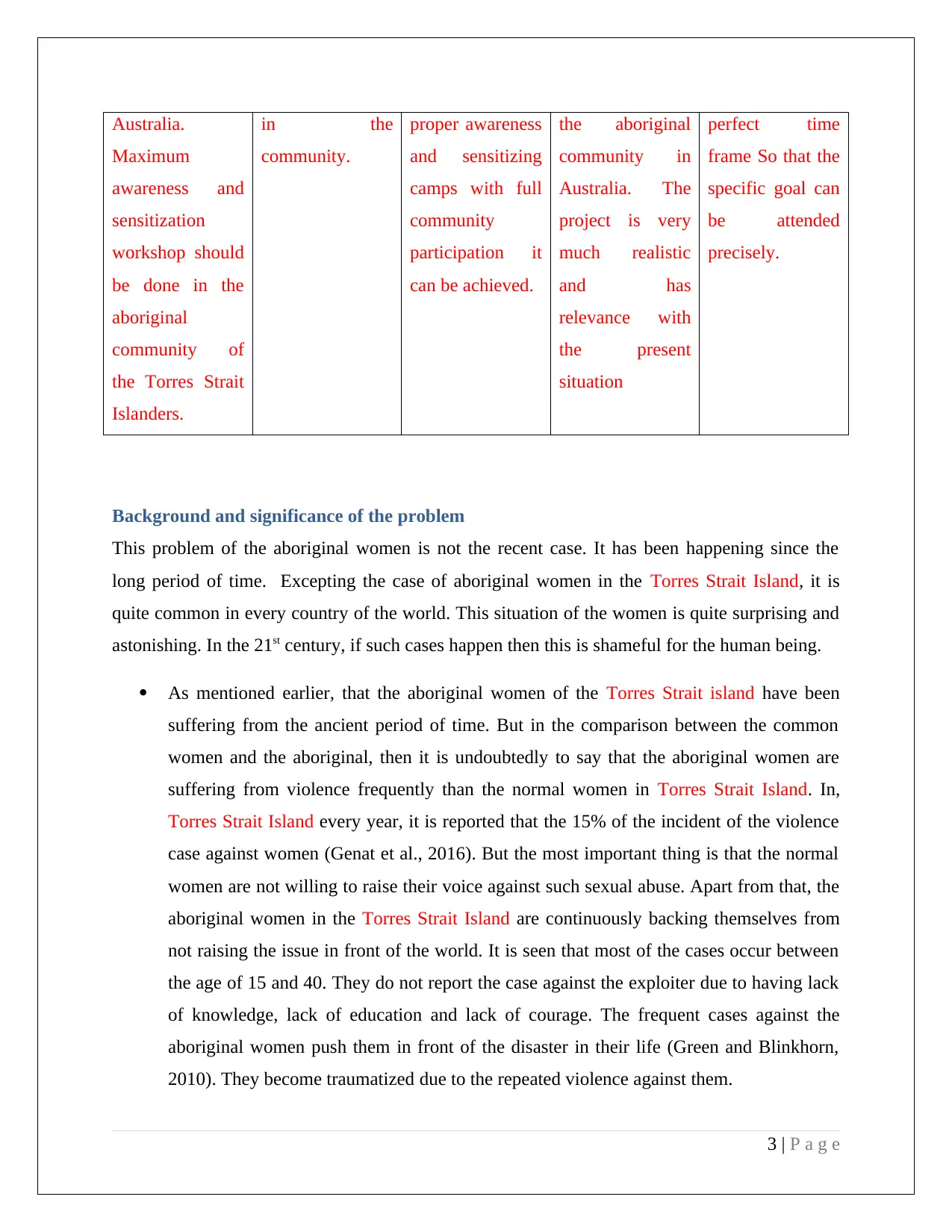
Australia.
Maximum
awareness and
sensitization
workshop should
be done in the
aboriginal
community of
the Torres Strait
Islanders.
in the
community.
proper awareness
and sensitizing
camps with full
community
participation it
can be achieved.
the aboriginal
community in
Australia. The
project is very
much realistic
and has
relevance with
the present
situation
perfect time
frame So that the
specific goal can
be attended
precisely.
Background and significance of the problem
This problem of the aboriginal women is not the recent case. It has been happening since the
long period of time. Excepting the case of aboriginal women in the Torres Strait Island, it is
quite common in every country of the world. This situation of the women is quite surprising and
astonishing. In the 21st century, if such cases happen then this is shameful for the human being.
As mentioned earlier, that the aboriginal women of the Torres Strait island have been
suffering from the ancient period of time. But in the comparison between the common
women and the aboriginal, then it is undoubtedly to say that the aboriginal women are
suffering from violence frequently than the normal women in Torres Strait Island. In,
Torres Strait Island every year, it is reported that the 15% of the incident of the violence
case against women (Genat et al., 2016). But the most important thing is that the normal
women are not willing to raise their voice against such sexual abuse. Apart from that, the
aboriginal women in the Torres Strait Island are continuously backing themselves from
not raising the issue in front of the world. It is seen that most of the cases occur between
the age of 15 and 40. They do not report the case against the exploiter due to having lack
of knowledge, lack of education and lack of courage. The frequent cases against the
aboriginal women push them in front of the disaster in their life (Green and Blinkhorn,
2010). They become traumatized due to the repeated violence against them.
3 | P a g e
Maximum
awareness and
sensitization
workshop should
be done in the
aboriginal
community of
the Torres Strait
Islanders.
in the
community.
proper awareness
and sensitizing
camps with full
community
participation it
can be achieved.
the aboriginal
community in
Australia. The
project is very
much realistic
and has
relevance with
the present
situation
perfect time
frame So that the
specific goal can
be attended
precisely.
Background and significance of the problem
This problem of the aboriginal women is not the recent case. It has been happening since the
long period of time. Excepting the case of aboriginal women in the Torres Strait Island, it is
quite common in every country of the world. This situation of the women is quite surprising and
astonishing. In the 21st century, if such cases happen then this is shameful for the human being.
As mentioned earlier, that the aboriginal women of the Torres Strait island have been
suffering from the ancient period of time. But in the comparison between the common
women and the aboriginal, then it is undoubtedly to say that the aboriginal women are
suffering from violence frequently than the normal women in Torres Strait Island. In,
Torres Strait Island every year, it is reported that the 15% of the incident of the violence
case against women (Genat et al., 2016). But the most important thing is that the normal
women are not willing to raise their voice against such sexual abuse. Apart from that, the
aboriginal women in the Torres Strait Island are continuously backing themselves from
not raising the issue in front of the world. It is seen that most of the cases occur between
the age of 15 and 40. They do not report the case against the exploiter due to having lack
of knowledge, lack of education and lack of courage. The frequent cases against the
aboriginal women push them in front of the disaster in their life (Green and Blinkhorn,
2010). They become traumatized due to the repeated violence against them.
3 | P a g e
Secure Best Marks with AI Grader
Need help grading? Try our AI Grader for instant feedback on your assignments.
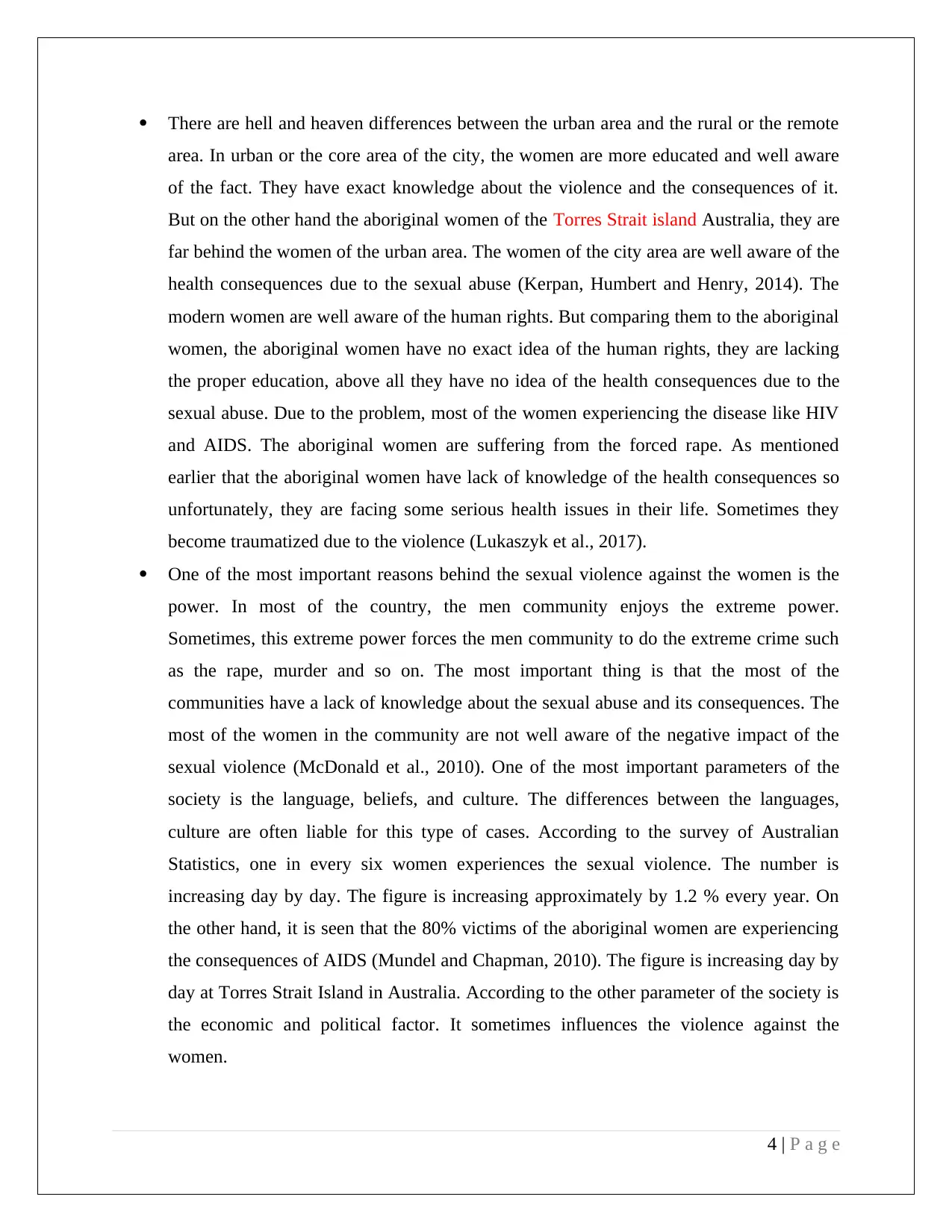
There are hell and heaven differences between the urban area and the rural or the remote
area. In urban or the core area of the city, the women are more educated and well aware
of the fact. They have exact knowledge about the violence and the consequences of it.
But on the other hand the aboriginal women of the Torres Strait island Australia, they are
far behind the women of the urban area. The women of the city area are well aware of the
health consequences due to the sexual abuse (Kerpan, Humbert and Henry, 2014). The
modern women are well aware of the human rights. But comparing them to the aboriginal
women, the aboriginal women have no exact idea of the human rights, they are lacking
the proper education, above all they have no idea of the health consequences due to the
sexual abuse. Due to the problem, most of the women experiencing the disease like HIV
and AIDS. The aboriginal women are suffering from the forced rape. As mentioned
earlier that the aboriginal women have lack of knowledge of the health consequences so
unfortunately, they are facing some serious health issues in their life. Sometimes they
become traumatized due to the violence (Lukaszyk et al., 2017).
One of the most important reasons behind the sexual violence against the women is the
power. In most of the country, the men community enjoys the extreme power.
Sometimes, this extreme power forces the men community to do the extreme crime such
as the rape, murder and so on. The most important thing is that the most of the
communities have a lack of knowledge about the sexual abuse and its consequences. The
most of the women in the community are not well aware of the negative impact of the
sexual violence (McDonald et al., 2010). One of the most important parameters of the
society is the language, beliefs, and culture. The differences between the languages,
culture are often liable for this type of cases. According to the survey of Australian
Statistics, one in every six women experiences the sexual violence. The number is
increasing day by day. The figure is increasing approximately by 1.2 % every year. On
the other hand, it is seen that the 80% victims of the aboriginal women are experiencing
the consequences of AIDS (Mundel and Chapman, 2010). The figure is increasing day by
day at Torres Strait Island in Australia. According to the other parameter of the society is
the economic and political factor. It sometimes influences the violence against the
women.
4 | P a g e
area. In urban or the core area of the city, the women are more educated and well aware
of the fact. They have exact knowledge about the violence and the consequences of it.
But on the other hand the aboriginal women of the Torres Strait island Australia, they are
far behind the women of the urban area. The women of the city area are well aware of the
health consequences due to the sexual abuse (Kerpan, Humbert and Henry, 2014). The
modern women are well aware of the human rights. But comparing them to the aboriginal
women, the aboriginal women have no exact idea of the human rights, they are lacking
the proper education, above all they have no idea of the health consequences due to the
sexual abuse. Due to the problem, most of the women experiencing the disease like HIV
and AIDS. The aboriginal women are suffering from the forced rape. As mentioned
earlier that the aboriginal women have lack of knowledge of the health consequences so
unfortunately, they are facing some serious health issues in their life. Sometimes they
become traumatized due to the violence (Lukaszyk et al., 2017).
One of the most important reasons behind the sexual violence against the women is the
power. In most of the country, the men community enjoys the extreme power.
Sometimes, this extreme power forces the men community to do the extreme crime such
as the rape, murder and so on. The most important thing is that the most of the
communities have a lack of knowledge about the sexual abuse and its consequences. The
most of the women in the community are not well aware of the negative impact of the
sexual violence (McDonald et al., 2010). One of the most important parameters of the
society is the language, beliefs, and culture. The differences between the languages,
culture are often liable for this type of cases. According to the survey of Australian
Statistics, one in every six women experiences the sexual violence. The number is
increasing day by day. The figure is increasing approximately by 1.2 % every year. On
the other hand, it is seen that the 80% victims of the aboriginal women are experiencing
the consequences of AIDS (Mundel and Chapman, 2010). The figure is increasing day by
day at Torres Strait Island in Australia. According to the other parameter of the society is
the economic and political factor. It sometimes influences the violence against the
women.
4 | P a g e
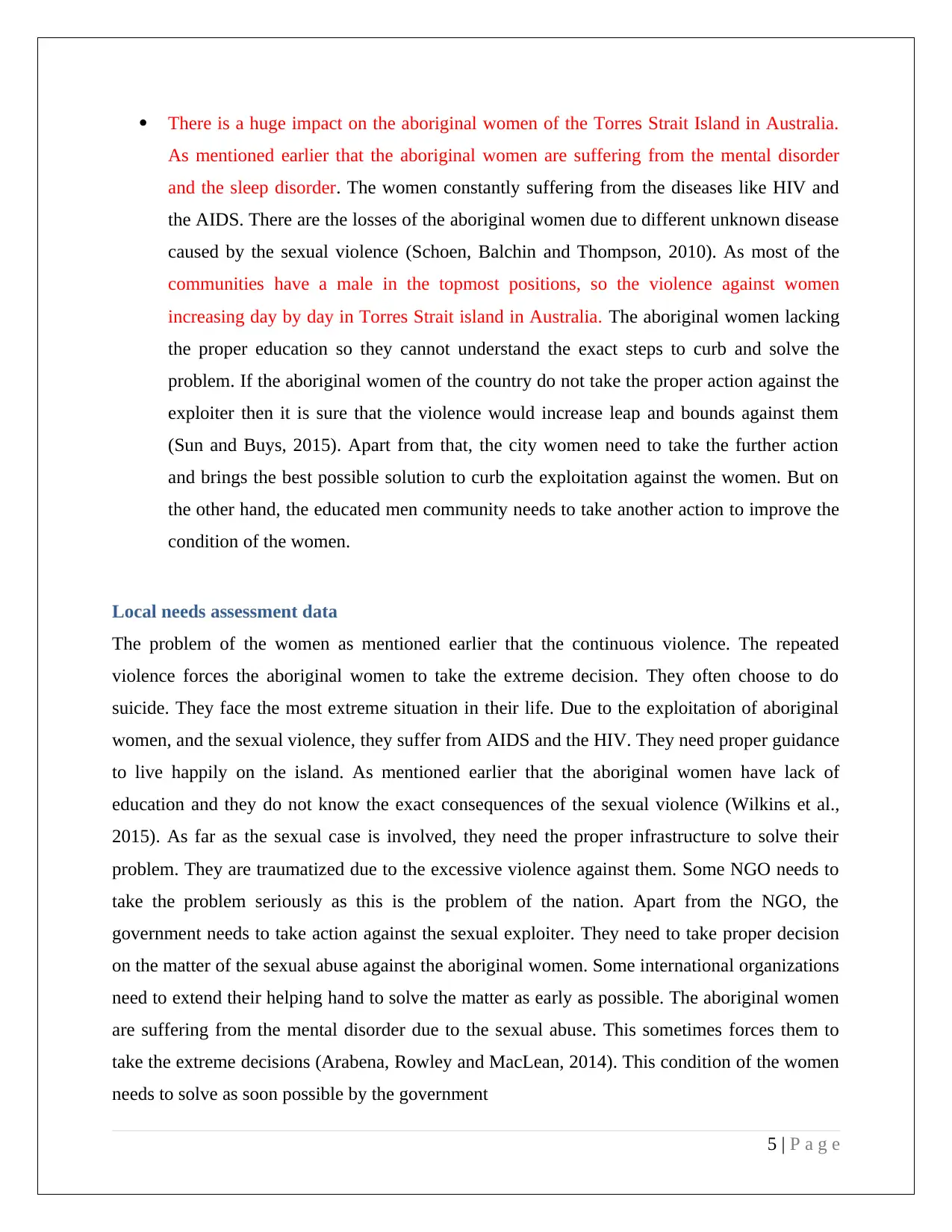
There is a huge impact on the aboriginal women of the Torres Strait Island in Australia.
As mentioned earlier that the aboriginal women are suffering from the mental disorder
and the sleep disorder. The women constantly suffering from the diseases like HIV and
the AIDS. There are the losses of the aboriginal women due to different unknown disease
caused by the sexual violence (Schoen, Balchin and Thompson, 2010). As most of the
communities have a male in the topmost positions, so the violence against women
increasing day by day in Torres Strait island in Australia. The aboriginal women lacking
the proper education so they cannot understand the exact steps to curb and solve the
problem. If the aboriginal women of the country do not take the proper action against the
exploiter then it is sure that the violence would increase leap and bounds against them
(Sun and Buys, 2015). Apart from that, the city women need to take the further action
and brings the best possible solution to curb the exploitation against the women. But on
the other hand, the educated men community needs to take another action to improve the
condition of the women.
Local needs assessment data
The problem of the women as mentioned earlier that the continuous violence. The repeated
violence forces the aboriginal women to take the extreme decision. They often choose to do
suicide. They face the most extreme situation in their life. Due to the exploitation of aboriginal
women, and the sexual violence, they suffer from AIDS and the HIV. They need proper guidance
to live happily on the island. As mentioned earlier that the aboriginal women have lack of
education and they do not know the exact consequences of the sexual violence (Wilkins et al.,
2015). As far as the sexual case is involved, they need the proper infrastructure to solve their
problem. They are traumatized due to the excessive violence against them. Some NGO needs to
take the problem seriously as this is the problem of the nation. Apart from the NGO, the
government needs to take action against the sexual exploiter. They need to take proper decision
on the matter of the sexual abuse against the aboriginal women. Some international organizations
need to extend their helping hand to solve the matter as early as possible. The aboriginal women
are suffering from the mental disorder due to the sexual abuse. This sometimes forces them to
take the extreme decisions (Arabena, Rowley and MacLean, 2014). This condition of the women
needs to solve as soon possible by the government
5 | P a g e
As mentioned earlier that the aboriginal women are suffering from the mental disorder
and the sleep disorder. The women constantly suffering from the diseases like HIV and
the AIDS. There are the losses of the aboriginal women due to different unknown disease
caused by the sexual violence (Schoen, Balchin and Thompson, 2010). As most of the
communities have a male in the topmost positions, so the violence against women
increasing day by day in Torres Strait island in Australia. The aboriginal women lacking
the proper education so they cannot understand the exact steps to curb and solve the
problem. If the aboriginal women of the country do not take the proper action against the
exploiter then it is sure that the violence would increase leap and bounds against them
(Sun and Buys, 2015). Apart from that, the city women need to take the further action
and brings the best possible solution to curb the exploitation against the women. But on
the other hand, the educated men community needs to take another action to improve the
condition of the women.
Local needs assessment data
The problem of the women as mentioned earlier that the continuous violence. The repeated
violence forces the aboriginal women to take the extreme decision. They often choose to do
suicide. They face the most extreme situation in their life. Due to the exploitation of aboriginal
women, and the sexual violence, they suffer from AIDS and the HIV. They need proper guidance
to live happily on the island. As mentioned earlier that the aboriginal women have lack of
education and they do not know the exact consequences of the sexual violence (Wilkins et al.,
2015). As far as the sexual case is involved, they need the proper infrastructure to solve their
problem. They are traumatized due to the excessive violence against them. Some NGO needs to
take the problem seriously as this is the problem of the nation. Apart from the NGO, the
government needs to take action against the sexual exploiter. They need to take proper decision
on the matter of the sexual abuse against the aboriginal women. Some international organizations
need to extend their helping hand to solve the matter as early as possible. The aboriginal women
are suffering from the mental disorder due to the sexual abuse. This sometimes forces them to
take the extreme decisions (Arabena, Rowley and MacLean, 2014). This condition of the women
needs to solve as soon possible by the government
5 | P a g e

Project summary
The entire discussion emphasizes the case of the aboriginal women of the Torres Strait Island of
Australia. Their mental condition has been portrayed beautifully to bring the others attention to
the fact. Their condition is so pathetic that it cannot be thinkable in the 21st century. The extreme
power of the men has forced the aboriginal women to take the extreme decision. The men
communities are continuously exploiting the women. Sometimes they do forced rape. The above-
mentioned discussion portrays the exact reason behind the sexual abuse against the aboriginal
women. The discussion also urges the some NGO and the respective government to take the
proper action against this serious issue (Bailie et al., 2010). The discussion also displays the
negativity of the society which somehow liable for this extreme case against women. Apart from
that, the women do not have the proper amenities such as the education, knowledge of the
consequences of the unknown disease and so on. The above-mentioned discussion displays the
ideal feature of the men community in the society.
Project description
The project consists of the following parameters which are very important for the overall
awareness of the aboriginal male and female community in Torres Strait Island so that sexual
abuse and women violence can be restricted.
Individual risk Reduction: To protect the aboriginal women of the Torres Strait Island from the
sexual violence and to establish gender equality through monitoring, awareness and advocacy
programme. The philosophy of the programme must be positivist. The worker working in the
programmed should have a very positive state of mind. They should be very proactive in making
and implementing the action plan (Campbell et al., 2018). In the Individual risk assessment
Health check is an important parameter to find the intensity of the sexual abuse that has occurred
in the aboriginal women population. The program includes a medical camp where the aboriginal
women of all ages in the Torres Strait Island will have the facility to do a holistic checkup.
The health check-up will not only include physical health it will include the mental health of the
women. After the checkup families with the most sexual violence should be marked. Special
focus should be given to those families which have high sexual violence. Proper discussion and
awareness should be done to aware the males about the consequences of the sexual abuse
6 | P a g e
The entire discussion emphasizes the case of the aboriginal women of the Torres Strait Island of
Australia. Their mental condition has been portrayed beautifully to bring the others attention to
the fact. Their condition is so pathetic that it cannot be thinkable in the 21st century. The extreme
power of the men has forced the aboriginal women to take the extreme decision. The men
communities are continuously exploiting the women. Sometimes they do forced rape. The above-
mentioned discussion portrays the exact reason behind the sexual abuse against the aboriginal
women. The discussion also urges the some NGO and the respective government to take the
proper action against this serious issue (Bailie et al., 2010). The discussion also displays the
negativity of the society which somehow liable for this extreme case against women. Apart from
that, the women do not have the proper amenities such as the education, knowledge of the
consequences of the unknown disease and so on. The above-mentioned discussion displays the
ideal feature of the men community in the society.
Project description
The project consists of the following parameters which are very important for the overall
awareness of the aboriginal male and female community in Torres Strait Island so that sexual
abuse and women violence can be restricted.
Individual risk Reduction: To protect the aboriginal women of the Torres Strait Island from the
sexual violence and to establish gender equality through monitoring, awareness and advocacy
programme. The philosophy of the programme must be positivist. The worker working in the
programmed should have a very positive state of mind. They should be very proactive in making
and implementing the action plan (Campbell et al., 2018). In the Individual risk assessment
Health check is an important parameter to find the intensity of the sexual abuse that has occurred
in the aboriginal women population. The program includes a medical camp where the aboriginal
women of all ages in the Torres Strait Island will have the facility to do a holistic checkup.
The health check-up will not only include physical health it will include the mental health of the
women. After the checkup families with the most sexual violence should be marked. Special
focus should be given to those families which have high sexual violence. Proper discussion and
awareness should be done to aware the males about the consequences of the sexual abuse
6 | P a g e
Paraphrase This Document
Need a fresh take? Get an instant paraphrase of this document with our AI Paraphraser

(Colles, Maypilama and Brimblecombe, 2014). The female of those households should be
sensitized at the individual level so they can protect themselves or will be able to take necessary
steps during the case of sexual abuse.
Awareness and education in Individual level: The Awareness must be in the individual level.
The main reason for that is the aboriginal community in Torres Strait Island is less educated and
less aware of the circumstances of the sexual violence than the urban community. Hence through
the program, the aboriginal women and male of the Torres Strait Island at an individual level
should be sensitized about the issue so that the problem can be mitigated. This awareness in the
personal level can be done through the open-ended discussion, clarification and resolving of the
issue (Lee, O'Dea and Mathews, 2010).
Holistic community development: The whole community of the aboriginal people in the Torres
Strait Island should be developed and sensitized to the concept of the sexual violence.
Community awareness and sensitizing workshop can be done in the community. Focused group
discussion about the issue can be done in the community through meetings and gatherings. There
should be an open platform for debate in this issue. The primary focus will be sexual violence on
women of the Torres Strait island community. Young to middle-aged women are the main
victims of the sexual violence which should be focused. The whole community through proper
focused group discussion should be sensitized so they can understand the negative impacts of the
sexual violence (Lee, Midford and Malone, 2012). Since the aboriginal community in the Torres
Strait Island is not aware of the laws that are prevalent in the country for sexual violence against
the women it should be stated in the community through proper meetings. The organizations
which are working for this cause the communication numbers should be provided to the victims
in the Torres Strait Island so they can inform the proper authority in case of any sexual violence
in the aboriginal community.
In this part of the project, the overall community development should be taken care of by proper
communication. The philosophy which is to be taken here is humanistic philosophy.
Social Advocacy: Social Advocacy is one of the most important parameters which should be
covered in the program it will help the community to be sensitized and organized in this issue. In
the program, the target is to sensitize the population to such level that after the project they can
7 | P a g e
sensitized at the individual level so they can protect themselves or will be able to take necessary
steps during the case of sexual abuse.
Awareness and education in Individual level: The Awareness must be in the individual level.
The main reason for that is the aboriginal community in Torres Strait Island is less educated and
less aware of the circumstances of the sexual violence than the urban community. Hence through
the program, the aboriginal women and male of the Torres Strait Island at an individual level
should be sensitized about the issue so that the problem can be mitigated. This awareness in the
personal level can be done through the open-ended discussion, clarification and resolving of the
issue (Lee, O'Dea and Mathews, 2010).
Holistic community development: The whole community of the aboriginal people in the Torres
Strait Island should be developed and sensitized to the concept of the sexual violence.
Community awareness and sensitizing workshop can be done in the community. Focused group
discussion about the issue can be done in the community through meetings and gatherings. There
should be an open platform for debate in this issue. The primary focus will be sexual violence on
women of the Torres Strait island community. Young to middle-aged women are the main
victims of the sexual violence which should be focused. The whole community through proper
focused group discussion should be sensitized so they can understand the negative impacts of the
sexual violence (Lee, Midford and Malone, 2012). Since the aboriginal community in the Torres
Strait Island is not aware of the laws that are prevalent in the country for sexual violence against
the women it should be stated in the community through proper meetings. The organizations
which are working for this cause the communication numbers should be provided to the victims
in the Torres Strait Island so they can inform the proper authority in case of any sexual violence
in the aboriginal community.
In this part of the project, the overall community development should be taken care of by proper
communication. The philosophy which is to be taken here is humanistic philosophy.
Social Advocacy: Social Advocacy is one of the most important parameters which should be
covered in the program it will help the community to be sensitized and organized in this issue. In
the program, the target is to sensitize the population to such level that after the project they can
7 | P a g e
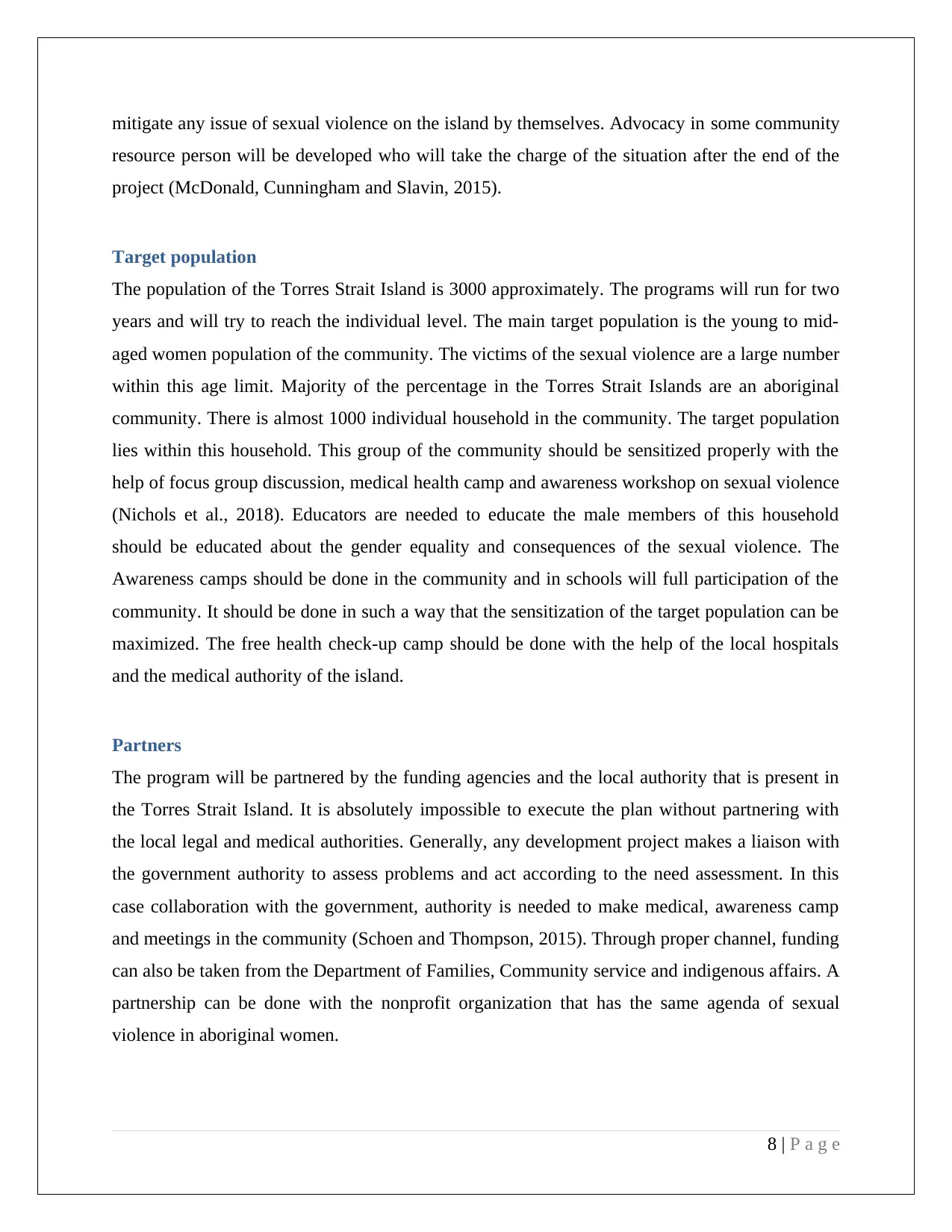
mitigate any issue of sexual violence on the island by themselves. Advocacy in some community
resource person will be developed who will take the charge of the situation after the end of the
project (McDonald, Cunningham and Slavin, 2015).
Target population
The population of the Torres Strait Island is 3000 approximately. The programs will run for two
years and will try to reach the individual level. The main target population is the young to mid-
aged women population of the community. The victims of the sexual violence are a large number
within this age limit. Majority of the percentage in the Torres Strait Islands are an aboriginal
community. There is almost 1000 individual household in the community. The target population
lies within this household. This group of the community should be sensitized properly with the
help of focus group discussion, medical health camp and awareness workshop on sexual violence
(Nichols et al., 2018). Educators are needed to educate the male members of this household
should be educated about the gender equality and consequences of the sexual violence. The
Awareness camps should be done in the community and in schools will full participation of the
community. It should be done in such a way that the sensitization of the target population can be
maximized. The free health check-up camp should be done with the help of the local hospitals
and the medical authority of the island.
Partners
The program will be partnered by the funding agencies and the local authority that is present in
the Torres Strait Island. It is absolutely impossible to execute the plan without partnering with
the local legal and medical authorities. Generally, any development project makes a liaison with
the government authority to assess problems and act according to the need assessment. In this
case collaboration with the government, authority is needed to make medical, awareness camp
and meetings in the community (Schoen and Thompson, 2015). Through proper channel, funding
can also be taken from the Department of Families, Community service and indigenous affairs. A
partnership can be done with the nonprofit organization that has the same agenda of sexual
violence in aboriginal women.
8 | P a g e
resource person will be developed who will take the charge of the situation after the end of the
project (McDonald, Cunningham and Slavin, 2015).
Target population
The population of the Torres Strait Island is 3000 approximately. The programs will run for two
years and will try to reach the individual level. The main target population is the young to mid-
aged women population of the community. The victims of the sexual violence are a large number
within this age limit. Majority of the percentage in the Torres Strait Islands are an aboriginal
community. There is almost 1000 individual household in the community. The target population
lies within this household. This group of the community should be sensitized properly with the
help of focus group discussion, medical health camp and awareness workshop on sexual violence
(Nichols et al., 2018). Educators are needed to educate the male members of this household
should be educated about the gender equality and consequences of the sexual violence. The
Awareness camps should be done in the community and in schools will full participation of the
community. It should be done in such a way that the sensitization of the target population can be
maximized. The free health check-up camp should be done with the help of the local hospitals
and the medical authority of the island.
Partners
The program will be partnered by the funding agencies and the local authority that is present in
the Torres Strait Island. It is absolutely impossible to execute the plan without partnering with
the local legal and medical authorities. Generally, any development project makes a liaison with
the government authority to assess problems and act according to the need assessment. In this
case collaboration with the government, authority is needed to make medical, awareness camp
and meetings in the community (Schoen and Thompson, 2015). Through proper channel, funding
can also be taken from the Department of Families, Community service and indigenous affairs. A
partnership can be done with the nonprofit organization that has the same agenda of sexual
violence in aboriginal women.
8 | P a g e

Other similar services
Other similar services like mitigation of drug use and children abuse programmers are running in
the New South Wales. This is also a community development program. The activities of the
programme include social advocacy. The target population, in this case, is the adolescent youths
who need proper guidance to come into the mainstream of the society. Sensitization workshops
and medical workshops are done in school; proper education should be given to the youths for
proper direction.
Measure of success
In this kind of development awareness programs, it is sometimes challenging to measure the
success of the project. One of the measures of success will be monitoring of the individual
households for any case of sexual violence in the aboriginal women in the island. Then the
percentage of reports should be compared before and after the program which will help in the
calculating the success rate of the project (Sinclair et al., 2015). The previous report as should be
done by baseline data of the community which can be done through survey s and collection of
data from the authorities in the area.
Sustainability
The sustainability of the project is totally dependent on the designing of the project. It is very
important for any developmental project to be sustainable. One of the methods to make this
project sustain is to create a community resource person among the aboriginal community in the
Torres Strait Island who will work I liaison with the local authority. For every 100 household
one communities, resource people should be made. The capacity of the community resource
person should be built by the professionals of the project. This Community resource person will
help to sustain the measures of the project (Taylor et al., 2012). The sensitization workshop can
be carried on by the resource person who will lead to the sustainability of the project.
Simple program logic
Inputs Outputs
Activity
Output
Participation
Short-Term
outcomes
Medium-term
outcomes
Long-term
outcomes
Professional Workshop The Proper data The medium- The long-
9 | P a g e
Other similar services like mitigation of drug use and children abuse programmers are running in
the New South Wales. This is also a community development program. The activities of the
programme include social advocacy. The target population, in this case, is the adolescent youths
who need proper guidance to come into the mainstream of the society. Sensitization workshops
and medical workshops are done in school; proper education should be given to the youths for
proper direction.
Measure of success
In this kind of development awareness programs, it is sometimes challenging to measure the
success of the project. One of the measures of success will be monitoring of the individual
households for any case of sexual violence in the aboriginal women in the island. Then the
percentage of reports should be compared before and after the program which will help in the
calculating the success rate of the project (Sinclair et al., 2015). The previous report as should be
done by baseline data of the community which can be done through survey s and collection of
data from the authorities in the area.
Sustainability
The sustainability of the project is totally dependent on the designing of the project. It is very
important for any developmental project to be sustainable. One of the methods to make this
project sustain is to create a community resource person among the aboriginal community in the
Torres Strait Island who will work I liaison with the local authority. For every 100 household
one communities, resource people should be made. The capacity of the community resource
person should be built by the professionals of the project. This Community resource person will
help to sustain the measures of the project (Taylor et al., 2012). The sensitization workshop can
be carried on by the resource person who will lead to the sustainability of the project.
Simple program logic
Inputs Outputs
Activity
Output
Participation
Short-Term
outcomes
Medium-term
outcomes
Long-term
outcomes
Professional Workshop The Proper data The medium- The long-
9 | P a g e
Secure Best Marks with AI Grader
Need help grading? Try our AI Grader for instant feedback on your assignments.
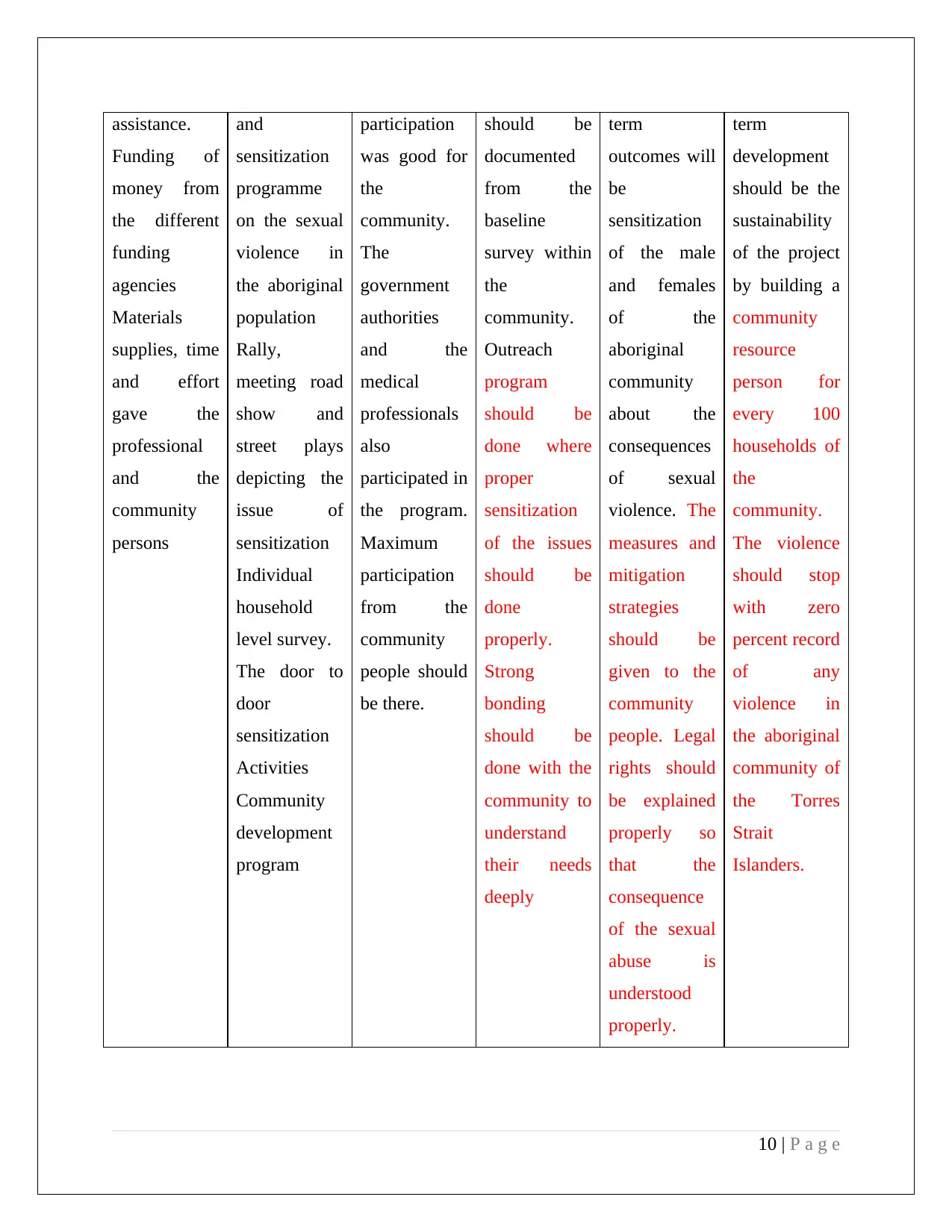
assistance.
Funding of
money from
the different
funding
agencies
Materials
supplies, time
and effort
gave the
professional
and the
community
persons
and
sensitization
programme
on the sexual
violence in
the aboriginal
population
Rally,
meeting road
show and
street plays
depicting the
issue of
sensitization
Individual
household
level survey.
The door to
door
sensitization
Activities
Community
development
program
participation
was good for
the
community.
The
government
authorities
and the
medical
professionals
also
participated in
the program.
Maximum
participation
from the
community
people should
be there.
should be
documented
from the
baseline
survey within
the
community.
Outreach
program
should be
done where
proper
sensitization
of the issues
should be
done
properly.
Strong
bonding
should be
done with the
community to
understand
their needs
deeply
term
outcomes will
be
sensitization
of the male
and females
of the
aboriginal
community
about the
consequences
of sexual
violence. The
measures and
mitigation
strategies
should be
given to the
community
people. Legal
rights should
be explained
properly so
that the
consequence
of the sexual
abuse is
understood
properly.
term
development
should be the
sustainability
of the project
by building a
community
resource
person for
every 100
households of
the
community.
The violence
should stop
with zero
percent record
of any
violence in
the aboriginal
community of
the Torres
Strait
Islanders.
10 | P a g e
Funding of
money from
the different
funding
agencies
Materials
supplies, time
and effort
gave the
professional
and the
community
persons
and
sensitization
programme
on the sexual
violence in
the aboriginal
population
Rally,
meeting road
show and
street plays
depicting the
issue of
sensitization
Individual
household
level survey.
The door to
door
sensitization
Activities
Community
development
program
participation
was good for
the
community.
The
government
authorities
and the
medical
professionals
also
participated in
the program.
Maximum
participation
from the
community
people should
be there.
should be
documented
from the
baseline
survey within
the
community.
Outreach
program
should be
done where
proper
sensitization
of the issues
should be
done
properly.
Strong
bonding
should be
done with the
community to
understand
their needs
deeply
term
outcomes will
be
sensitization
of the male
and females
of the
aboriginal
community
about the
consequences
of sexual
violence. The
measures and
mitigation
strategies
should be
given to the
community
people. Legal
rights should
be explained
properly so
that the
consequence
of the sexual
abuse is
understood
properly.
term
development
should be the
sustainability
of the project
by building a
community
resource
person for
every 100
households of
the
community.
The violence
should stop
with zero
percent record
of any
violence in
the aboriginal
community of
the Torres
Strait
Islanders.
10 | P a g e
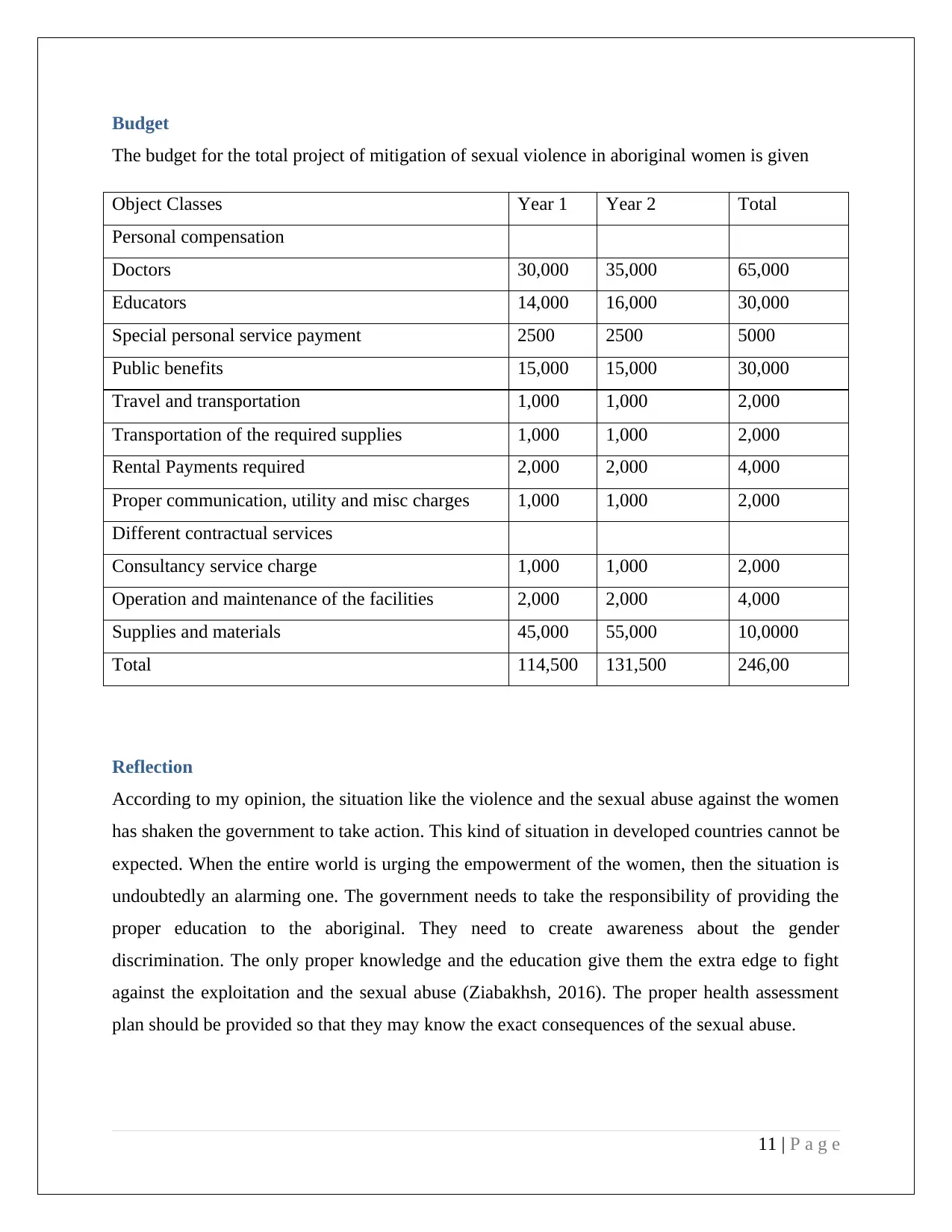
Budget
The budget for the total project of mitigation of sexual violence in aboriginal women is given
Object Classes Year 1 Year 2 Total
Personal compensation
Doctors 30,000 35,000 65,000
Educators 14,000 16,000 30,000
Special personal service payment 2500 2500 5000
Public benefits 15,000 15,000 30,000
Travel and transportation 1,000 1,000 2,000
Transportation of the required supplies 1,000 1,000 2,000
Rental Payments required 2,000 2,000 4,000
Proper communication, utility and misc charges 1,000 1,000 2,000
Different contractual services
Consultancy service charge 1,000 1,000 2,000
Operation and maintenance of the facilities 2,000 2,000 4,000
Supplies and materials 45,000 55,000 10,0000
Total 114,500 131,500 246,00
Reflection
According to my opinion, the situation like the violence and the sexual abuse against the women
has shaken the government to take action. This kind of situation in developed countries cannot be
expected. When the entire world is urging the empowerment of the women, then the situation is
undoubtedly an alarming one. The government needs to take the responsibility of providing the
proper education to the aboriginal. They need to create awareness about the gender
discrimination. The only proper knowledge and the education give them the extra edge to fight
against the exploitation and the sexual abuse (Ziabakhsh, 2016). The proper health assessment
plan should be provided so that they may know the exact consequences of the sexual abuse.
11 | P a g e
The budget for the total project of mitigation of sexual violence in aboriginal women is given
Object Classes Year 1 Year 2 Total
Personal compensation
Doctors 30,000 35,000 65,000
Educators 14,000 16,000 30,000
Special personal service payment 2500 2500 5000
Public benefits 15,000 15,000 30,000
Travel and transportation 1,000 1,000 2,000
Transportation of the required supplies 1,000 1,000 2,000
Rental Payments required 2,000 2,000 4,000
Proper communication, utility and misc charges 1,000 1,000 2,000
Different contractual services
Consultancy service charge 1,000 1,000 2,000
Operation and maintenance of the facilities 2,000 2,000 4,000
Supplies and materials 45,000 55,000 10,0000
Total 114,500 131,500 246,00
Reflection
According to my opinion, the situation like the violence and the sexual abuse against the women
has shaken the government to take action. This kind of situation in developed countries cannot be
expected. When the entire world is urging the empowerment of the women, then the situation is
undoubtedly an alarming one. The government needs to take the responsibility of providing the
proper education to the aboriginal. They need to create awareness about the gender
discrimination. The only proper knowledge and the education give them the extra edge to fight
against the exploitation and the sexual abuse (Ziabakhsh, 2016). The proper health assessment
plan should be provided so that they may know the exact consequences of the sexual abuse.
11 | P a g e
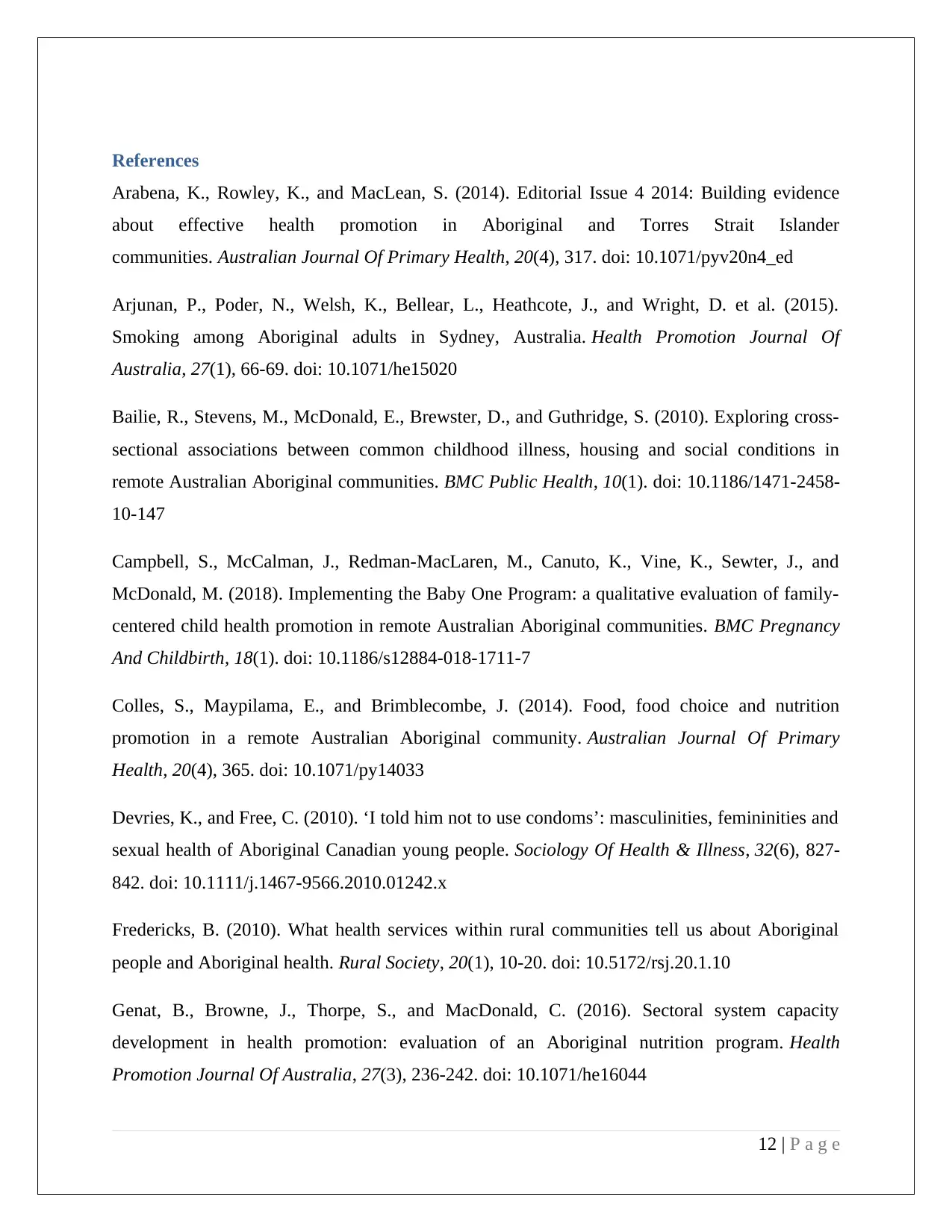
References
Arabena, K., Rowley, K., and MacLean, S. (2014). Editorial Issue 4 2014: Building evidence
about effective health promotion in Aboriginal and Torres Strait Islander
communities. Australian Journal Of Primary Health, 20(4), 317. doi: 10.1071/pyv20n4_ed
Arjunan, P., Poder, N., Welsh, K., Bellear, L., Heathcote, J., and Wright, D. et al. (2015).
Smoking among Aboriginal adults in Sydney, Australia. Health Promotion Journal Of
Australia, 27(1), 66-69. doi: 10.1071/he15020
Bailie, R., Stevens, M., McDonald, E., Brewster, D., and Guthridge, S. (2010). Exploring cross-
sectional associations between common childhood illness, housing and social conditions in
remote Australian Aboriginal communities. BMC Public Health, 10(1). doi: 10.1186/1471-2458-
10-147
Campbell, S., McCalman, J., Redman-MacLaren, M., Canuto, K., Vine, K., Sewter, J., and
McDonald, M. (2018). Implementing the Baby One Program: a qualitative evaluation of family-
centered child health promotion in remote Australian Aboriginal communities. BMC Pregnancy
And Childbirth, 18(1). doi: 10.1186/s12884-018-1711-7
Colles, S., Maypilama, E., and Brimblecombe, J. (2014). Food, food choice and nutrition
promotion in a remote Australian Aboriginal community. Australian Journal Of Primary
Health, 20(4), 365. doi: 10.1071/py14033
Devries, K., and Free, C. (2010). ‘I told him not to use condoms’: masculinities, femininities and
sexual health of Aboriginal Canadian young people. Sociology Of Health & Illness, 32(6), 827-
842. doi: 10.1111/j.1467-9566.2010.01242.x
Fredericks, B. (2010). What health services within rural communities tell us about Aboriginal
people and Aboriginal health. Rural Society, 20(1), 10-20. doi: 10.5172/rsj.20.1.10
Genat, B., Browne, J., Thorpe, S., and MacDonald, C. (2016). Sectoral system capacity
development in health promotion: evaluation of an Aboriginal nutrition program. Health
Promotion Journal Of Australia, 27(3), 236-242. doi: 10.1071/he16044
12 | P a g e
Arabena, K., Rowley, K., and MacLean, S. (2014). Editorial Issue 4 2014: Building evidence
about effective health promotion in Aboriginal and Torres Strait Islander
communities. Australian Journal Of Primary Health, 20(4), 317. doi: 10.1071/pyv20n4_ed
Arjunan, P., Poder, N., Welsh, K., Bellear, L., Heathcote, J., and Wright, D. et al. (2015).
Smoking among Aboriginal adults in Sydney, Australia. Health Promotion Journal Of
Australia, 27(1), 66-69. doi: 10.1071/he15020
Bailie, R., Stevens, M., McDonald, E., Brewster, D., and Guthridge, S. (2010). Exploring cross-
sectional associations between common childhood illness, housing and social conditions in
remote Australian Aboriginal communities. BMC Public Health, 10(1). doi: 10.1186/1471-2458-
10-147
Campbell, S., McCalman, J., Redman-MacLaren, M., Canuto, K., Vine, K., Sewter, J., and
McDonald, M. (2018). Implementing the Baby One Program: a qualitative evaluation of family-
centered child health promotion in remote Australian Aboriginal communities. BMC Pregnancy
And Childbirth, 18(1). doi: 10.1186/s12884-018-1711-7
Colles, S., Maypilama, E., and Brimblecombe, J. (2014). Food, food choice and nutrition
promotion in a remote Australian Aboriginal community. Australian Journal Of Primary
Health, 20(4), 365. doi: 10.1071/py14033
Devries, K., and Free, C. (2010). ‘I told him not to use condoms’: masculinities, femininities and
sexual health of Aboriginal Canadian young people. Sociology Of Health & Illness, 32(6), 827-
842. doi: 10.1111/j.1467-9566.2010.01242.x
Fredericks, B. (2010). What health services within rural communities tell us about Aboriginal
people and Aboriginal health. Rural Society, 20(1), 10-20. doi: 10.5172/rsj.20.1.10
Genat, B., Browne, J., Thorpe, S., and MacDonald, C. (2016). Sectoral system capacity
development in health promotion: evaluation of an Aboriginal nutrition program. Health
Promotion Journal Of Australia, 27(3), 236-242. doi: 10.1071/he16044
12 | P a g e
Paraphrase This Document
Need a fresh take? Get an instant paraphrase of this document with our AI Paraphraser

Green, J., and Blinkhorn, A. (2010). How can inequalities in the Oral Health of Australian
Aboriginal people be addressed?. International Journal Of Health Promotion And
Education, 48(4), 107-110. doi: 10.1080/14635240.2010.10708192
Kerpan, S., Humbert, M., and Henry, C. (2014). Determinants of Diet for Urban Aboriginal
Youth. Health Promotion Practice, 16(3), 392-400. doi: 10.1177/1524839914557862
Lee, A., O'Dea, K., and Mathews, J. (2010). Apparent dietary intake in remote Aboriginal
communities. Australian Journal Of Public Health, 18(2), 190-197. doi: 10.1111/j.1753-
6405.1994.tb00224.x
Lee, L., Midford, R., and Malone, S. (2012). The Dampier Peninsula Prevention Project:
working with a group of remote Australian Aboriginal communities to address alcohol and drug
use. International Journal Of Health Promotion And Education, 50(3), 111-124. doi:
10.1080/14635240.2012.661966
Lukaszyk, C., Coombes, J., Sherrington, C., Tiedemann, A., Keay, L., and Mackean, T. et al.
(2017). The Ironbark program: Implementation and impact of a community-based fall prevention
pilot program for older Aboriginal and Torres Strait Islander people. Health Promotion Journal
Of Australia, 29(2), 189-198. doi: 10.1002/hpja.25
McDonald, E., Bailie, R., Grace, J., and Brewster, D. (2010). An ecological approach to health
promotion in remote Australian Aboriginal communities. Health Promotion International, 25(1),
42-53. doi: 10.1093/heapro/daq004
McDonald, E., Cunningham, T., and Slavin, N. (2015). Evaluating a handwashing with soap
program in Australian remote Aboriginal communities: a pre and post intervention study
design. BMC Public Health, 15(1). doi: 10.1186/s12889-015-2503-x
Mundel, E., and Chapman, G. (2010). A decolonizing approach to health promotion in Canada:
the case of the Urban Aboriginal Community Kitchen Garden Project. Health Promotion
International, 25(2), 166-173. doi: 10.1093/heapro/daq016
Nichols, N., McFarlane, K., Gibson, P., Millard, F., Packer, A., and McDonald, M. (2018).
Skills, systems, and supports: An Aboriginal Community Controlled Health Service (Apunipima)
13 | P a g e
Aboriginal people be addressed?. International Journal Of Health Promotion And
Education, 48(4), 107-110. doi: 10.1080/14635240.2010.10708192
Kerpan, S., Humbert, M., and Henry, C. (2014). Determinants of Diet for Urban Aboriginal
Youth. Health Promotion Practice, 16(3), 392-400. doi: 10.1177/1524839914557862
Lee, A., O'Dea, K., and Mathews, J. (2010). Apparent dietary intake in remote Aboriginal
communities. Australian Journal Of Public Health, 18(2), 190-197. doi: 10.1111/j.1753-
6405.1994.tb00224.x
Lee, L., Midford, R., and Malone, S. (2012). The Dampier Peninsula Prevention Project:
working with a group of remote Australian Aboriginal communities to address alcohol and drug
use. International Journal Of Health Promotion And Education, 50(3), 111-124. doi:
10.1080/14635240.2012.661966
Lukaszyk, C., Coombes, J., Sherrington, C., Tiedemann, A., Keay, L., and Mackean, T. et al.
(2017). The Ironbark program: Implementation and impact of a community-based fall prevention
pilot program for older Aboriginal and Torres Strait Islander people. Health Promotion Journal
Of Australia, 29(2), 189-198. doi: 10.1002/hpja.25
McDonald, E., Bailie, R., Grace, J., and Brewster, D. (2010). An ecological approach to health
promotion in remote Australian Aboriginal communities. Health Promotion International, 25(1),
42-53. doi: 10.1093/heapro/daq004
McDonald, E., Cunningham, T., and Slavin, N. (2015). Evaluating a handwashing with soap
program in Australian remote Aboriginal communities: a pre and post intervention study
design. BMC Public Health, 15(1). doi: 10.1186/s12889-015-2503-x
Mundel, E., and Chapman, G. (2010). A decolonizing approach to health promotion in Canada:
the case of the Urban Aboriginal Community Kitchen Garden Project. Health Promotion
International, 25(2), 166-173. doi: 10.1093/heapro/daq016
Nichols, N., McFarlane, K., Gibson, P., Millard, F., Packer, A., and McDonald, M. (2018).
Skills, systems, and supports: An Aboriginal Community Controlled Health Service (Apunipima)
13 | P a g e
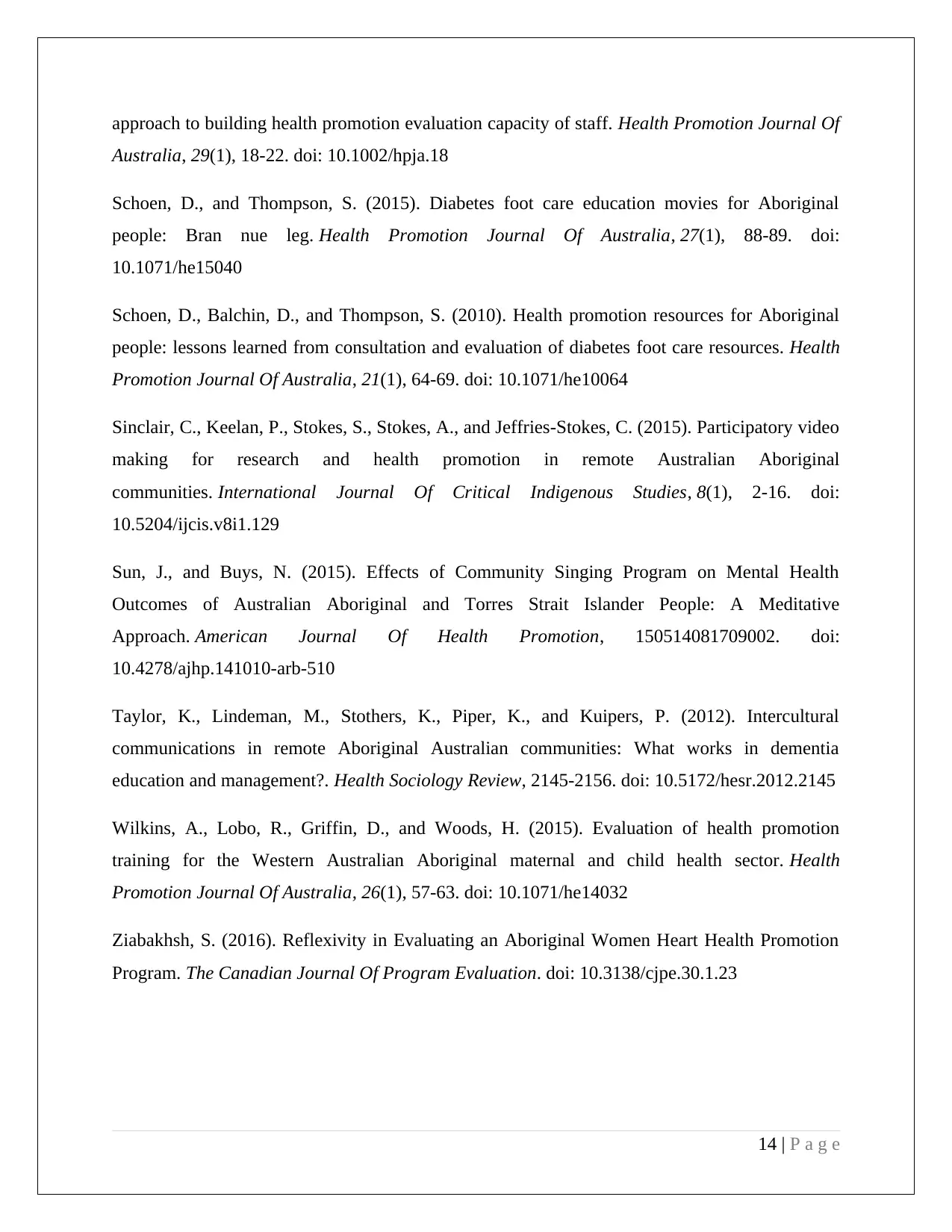
approach to building health promotion evaluation capacity of staff. Health Promotion Journal Of
Australia, 29(1), 18-22. doi: 10.1002/hpja.18
Schoen, D., and Thompson, S. (2015). Diabetes foot care education movies for Aboriginal
people: Bran nue leg. Health Promotion Journal Of Australia, 27(1), 88-89. doi:
10.1071/he15040
Schoen, D., Balchin, D., and Thompson, S. (2010). Health promotion resources for Aboriginal
people: lessons learned from consultation and evaluation of diabetes foot care resources. Health
Promotion Journal Of Australia, 21(1), 64-69. doi: 10.1071/he10064
Sinclair, C., Keelan, P., Stokes, S., Stokes, A., and Jeffries-Stokes, C. (2015). Participatory video
making for research and health promotion in remote Australian Aboriginal
communities. International Journal Of Critical Indigenous Studies, 8(1), 2-16. doi:
10.5204/ijcis.v8i1.129
Sun, J., and Buys, N. (2015). Effects of Community Singing Program on Mental Health
Outcomes of Australian Aboriginal and Torres Strait Islander People: A Meditative
Approach. American Journal Of Health Promotion, 150514081709002. doi:
10.4278/ajhp.141010-arb-510
Taylor, K., Lindeman, M., Stothers, K., Piper, K., and Kuipers, P. (2012). Intercultural
communications in remote Aboriginal Australian communities: What works in dementia
education and management?. Health Sociology Review, 2145-2156. doi: 10.5172/hesr.2012.2145
Wilkins, A., Lobo, R., Griffin, D., and Woods, H. (2015). Evaluation of health promotion
training for the Western Australian Aboriginal maternal and child health sector. Health
Promotion Journal Of Australia, 26(1), 57-63. doi: 10.1071/he14032
Ziabakhsh, S. (2016). Reflexivity in Evaluating an Aboriginal Women Heart Health Promotion
Program. The Canadian Journal Of Program Evaluation. doi: 10.3138/cjpe.30.1.23
14 | P a g e
Australia, 29(1), 18-22. doi: 10.1002/hpja.18
Schoen, D., and Thompson, S. (2015). Diabetes foot care education movies for Aboriginal
people: Bran nue leg. Health Promotion Journal Of Australia, 27(1), 88-89. doi:
10.1071/he15040
Schoen, D., Balchin, D., and Thompson, S. (2010). Health promotion resources for Aboriginal
people: lessons learned from consultation and evaluation of diabetes foot care resources. Health
Promotion Journal Of Australia, 21(1), 64-69. doi: 10.1071/he10064
Sinclair, C., Keelan, P., Stokes, S., Stokes, A., and Jeffries-Stokes, C. (2015). Participatory video
making for research and health promotion in remote Australian Aboriginal
communities. International Journal Of Critical Indigenous Studies, 8(1), 2-16. doi:
10.5204/ijcis.v8i1.129
Sun, J., and Buys, N. (2015). Effects of Community Singing Program on Mental Health
Outcomes of Australian Aboriginal and Torres Strait Islander People: A Meditative
Approach. American Journal Of Health Promotion, 150514081709002. doi:
10.4278/ajhp.141010-arb-510
Taylor, K., Lindeman, M., Stothers, K., Piper, K., and Kuipers, P. (2012). Intercultural
communications in remote Aboriginal Australian communities: What works in dementia
education and management?. Health Sociology Review, 2145-2156. doi: 10.5172/hesr.2012.2145
Wilkins, A., Lobo, R., Griffin, D., and Woods, H. (2015). Evaluation of health promotion
training for the Western Australian Aboriginal maternal and child health sector. Health
Promotion Journal Of Australia, 26(1), 57-63. doi: 10.1071/he14032
Ziabakhsh, S. (2016). Reflexivity in Evaluating an Aboriginal Women Heart Health Promotion
Program. The Canadian Journal Of Program Evaluation. doi: 10.3138/cjpe.30.1.23
14 | P a g e

15 | P a g e
1 out of 16
Related Documents
Your All-in-One AI-Powered Toolkit for Academic Success.
+13062052269
info@desklib.com
Available 24*7 on WhatsApp / Email
![[object Object]](/_next/static/media/star-bottom.7253800d.svg)
Unlock your academic potential
© 2024 | Zucol Services PVT LTD | All rights reserved.





